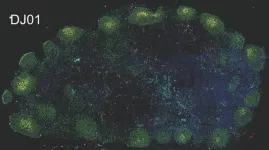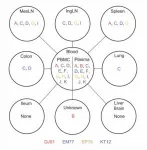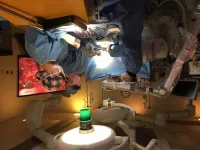(Press-News.org) In findings that have implications for potential new HIV therapies, researchers from Texas Biomedical Research Institute (Texas Biomed) used genetic sequencing techniques on the nonhuman primate version of the virus to identify that lymph nodes in the abdomen are the leading source of rebound infection after the first week of stopping antiretroviral treatment.
The study regarding simian immunodeficiency virus (SIV) was reported in the journal Science Translational Medicine. SIV is very closely related to HIV and is commonly used as a proxy to study HIV in animal models.
“Lymphoid tissues are known to be large reservoirs of latent HIV,” says Texas Biomed Professor Binhua “Julie” Ling, MD, PhD, and senior paper author. “However, there has been no definitive proof that they are the source of initial viral rebound – it has been a hypothesis. Now, we have evidence that SIV, and therefore potentially HIV, is hiding in specific types of lymph nodes and spleen tissues and is some of the first to reemerge in blood when treatment is stopped.”
Antiretroviral therapy (ART) does an excellent job at suppressing HIV to undetectable levels in the blood. However, small amounts of latent virus hide throughout the body, including in the brain, lung, gut, spleen, lymph nodes and other organs. When treatment is stopped, it opens the door for the virus to rebound.
“If we can identify the starting point of the virus rebound, we can work on developing treatments that target those tissues and stop the virus from spreading in the first place,” Dr. Ling says.
Dr. Ling and her team used several advanced genetic tools and sequencing techniques to track the virus. They teamed up with Brandon Keele, PhD, at the AIDS and Cancer Virus Program at Fredrick National Laboratory, who generated barcoded viruses. More than 9,000 individual viruses in the stock have unique genetic barcodes, “like when you go to Walmart and each item has its unique barcode to scan,” Dr. Ling explains.
Those barcoded viruses were given to seven nonhuman primates. After infection was established, the primates began receiving antiretroviral therapy. After four to six months on ART, the animals had either very small amounts or no detectable virus circulating in blood, much like people living with HIV who are on ART. When treatment was stopped after more than a year of ART, researchers were able to assess the very earliest stages of viral rebound.
Thanks to the barcoded viruses, they could identify in which tissues the virus had replicated the fastest and spread the furthest just seven days after treatment was stopped. They matched the barcodes most prevalent in blood plasma to the barcodes detected in specific tissues. Notably, the standard test did not detect any virus in blood at the seven-day mark – the amounts present were too low to be detected – but more sensitive deep sequencing did.
The researchers found three leading contributors: mesenteric lymph nodes, which are found in the tissue connecting the intestines to the abdominal wall; the spleen, which is a part of the lymphatic system that filters blood; and inguinal lymph nodes, which are located in the groin.
Through additional analyses, the researchers found CD4 T cells, a type of immune cell, in the mesenteric lymph nodes and spleen had higher amounts of intact virus and replication activity, which corresponded with higher rates of barcoded viruses from those regions in blood plasma. This was further confirmed using a novel technology by Qingsheng Li, PhD, at University of Nebraska-Lincoln.
Interestingly, some animals showed no evidence of viral rebound, indicating they had better control of the virus in the first week after treatment was stopped than others. Through single cell sequencing and transcriptomic analyses, the team identified a few genes of interest that contribute to dysregulation of normal cell function and could play a role in the differences between animals who experienced very rapid rebound and the animals who continued to suppress viral activity. The researchers are interested in learning more about these genes and how they might affect human immune responses.
The researchers acknowledge that the study size of seven animals is small, and that tissue sample size was also limited. Nonetheless, the results point to key organs to explore specific, targeted therapies.
“There are more than 800 lymph nodes throughout the body,” says Dr. Ling. “Knowing which types of lymph nodes to target can lead to more tailored therapies or treatments and hopefully prevent HIV from spreading and prolong HIV remission.”
END
Texas Biomed researchers pinpoint most likely source of HIV rebound infection
2024-01-24
ELSE PRESS RELEASES FROM THIS DATE:
Microplastics may be accumulating rapidly in endangered Galápagos penguins’ food web
2024-01-24
Microplastics, with a size from 1 micron to < 5 millimeters, are pervasive pollutants that have been found in all parts of the global ocean, and have made their way into the marine food webs. Researchers, led by University of British Columbia UBC’s Institute for the Oceans and Fisheries scientists and Ecuadorian researchers from Galápagos and the ESPOL Polytechnic School (Guayaquil, Ecuador), looked closely at how microplastic bioaccumulation was affecting the endangered Galápagos penguin (Spheniscus mendiculus) as an indicator species to trace how deeply microplastic bioaccumulation has entered the food web in the isolated Galápagos Islands.
An ...
The more the merrier: Research shows online interventions with social support help middle-aged adults with obesity lose weight
2024-01-24
Obesity is a problem in the United States. In fact, 42.5% of U.S. adults aged 20 and over have the disease. Not only is obesity the nation’s second leading cause of preventable death (behind only smoking cigarettes), it also leads to other serious health issues, including an increased risk of type 2 diabetes, high blood pressure, heart disease, stroke, cancer, sleep apnea and liver disease. The disease and its side effects impose a significant financial burden on America’s health care system.
As many make — and often fail to keep — New Year’s resolutions about exercise and weight loss goals, University ...
Salk Institute Professor Ronald Evans honored with Japan Prize
2024-01-24
LA JOLLA (January 22, 2024)—Salk Professor Ronald Evans has been named the 2024 recipient of the Japan Prize in the field of Medical Science and Pharmaceutical Science. The Japan Prize Foundation awards this prestigious international award annually to “express Japan’s gratitude to international society.”
"I am delighted to extend my congratulations to Ron for this well-deserved recognition in honor of his discovery of nuclear hormone receptors,” says Salk President Gerald Joyce. “This accomplishment not only reflects the exceptional caliber of Ron’s research ...
How does HIV get into the cell’s centre to kickstart infection?
2024-01-24
UNSW medical researcher Dr David Jacques and his team have discovered how the human immunodeficiency virus (HIV) breaches the cell nucleus to establish infection, a finding that has implications beyond HIV biology.
To infect cells, HIV must enter the target cell and make its way to the nucleus in the cell’s centre where enough copies of its genetic code can be produced to infect other cells.
To safely complete this quest, the virus builds a protective protein coat – a capsid – to shield itself from the host’s immune defences geared to destroy it. Until ...
One in five Colorado bumblebees are endangered, new report says
2024-01-24
On a cliffside at Mesa Verde National Park in southern Colorado, a fuzzy bee was industriously gnawing at the red sandstone. Making a loud grinding sound, the insect used its powerful jaws to drill tunnels and holes in rocks, where it would build a nest for raising offspring.
The bee, known as Anthophora pueblo, is a type of digger bee native to Colorado. Discovered less than a decade ago, the bee has quickly become Adrian Carper’s favorite pollinator.
“This is just one example of how crazily diverse our native bees are,” said Carper, an ...
Mayo Clinic study explores heart failure, uncovers gene’s role in recovery
2024-01-24
Mayo Clinic researchers studying the genetics of people who had recently developed dilated cardiomyopathy, one of the most common causes of heart failure, have found a particular gene to target for developing future drug therapy treatments. The disease makes it harder for the heart's left ventricle to pump blood effectively to the rest of the body. In this first genome-wide association study, the researchers sought to understand why some patients get better after developing the condition — and some don't.
"We found genetic variation in the CDCP1 gene, a gene that no one has heard of in ...
How studying defensive bacteria may help human gut health
2024-01-24
MSU has a satellite uplink/LTN TV studio and Comrex line for radio interviews upon request.
Images
EAST LANSING, Mich. – Thousands of types of bacteria live in the human gut. They help digest the food we eat and absorb nutrients, but these bacteria don’t just do this to be kind to humans, there is a benefit for them too.
Elizabeth Heath-Heckman, an assistant professor in the College of Natural Science, has received a five-year National Institutes of Health grant from the National Institute for General Medical Sciences totaling $1.9 million to support her research studying ...
Study: This protein may be the ‘glue’ that helps COVID virus stick
2024-01-24
When SARS-CoV-2 enters the human body, the virus’ spike protein binds to a cell, allowing the virus to infiltrate and begin replicating.
A new study from Tulane University, conducted in partnership with Florida International University and published in Protein Science, has identified a protein that may be the glue that helps COVID’s spike protein stick.
The study found that a small piece of a proteoglycan called perlecan LG3 – a protein most commonly found in blood vessels and the brain – ...
Can we predict when a migraine attack will occur?
2024-01-24
EMBARGOED FOR RELEASE UNTIL 4 P.M. ET, WEDNESDAY, JANUARY 24, 2024
MINNEAPOLIS – Migraine is often underdiagnosed and untreated, and even when it is treated, it can be difficult to treat early enough as well as find strategies to prevent attacks. A new study looks at ways to more accurately predict when a migraine will occur—through the use of mobile apps to track sleep, energy, emotions and stress—to enhance the ability to prevent attacks. The study is published in the January 24, 2024, online issue of Neurology®, the medical journal of ...
Researchers suggest changing gold standard of spine surgery from operative microscope to 3D exoscope
2024-01-24
While surgeons have more commonly used the exoscope in various intracranial procedures, its use in spinal surgery has been underreported.
Researchers and neurosurgeons at the Medical University of South Carolina (MUSC) retrospectively compared the operative microscope to the 3D exoscope in a recent study published in World Neurosurgery and found better outcomes among both surgeons and patients when using the exoscope.
Stephen Kalhorn, M.D., FAANS, was the principal investigator on the study, and he says the traditional operative microscope has ...






